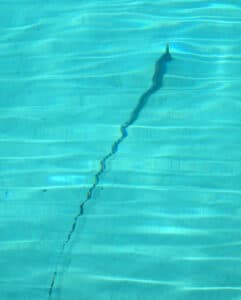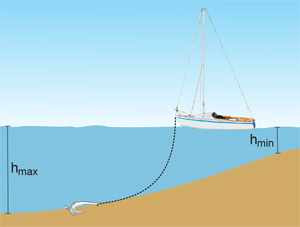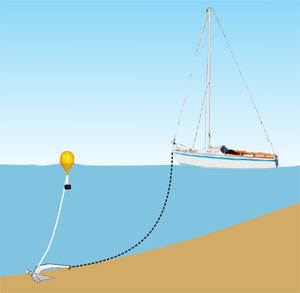In most nautical guides, we find advice on how to anchor, how much chain or rope we should lower into the water, and how much space we need around the vessel. In practice, however, we often encounter situations where this is simply not possible. This usually happens during the season when anchorages are crowded with vessels. It’s difficult to find space that provides good protection from the wind and is large enough for safely anchoring our vessel.
In such situations, we must make do. We can help ourselves with some tricks that will ensure safe and worry-free anchoring, and a peaceful sleep if we overnight at anchor.
Facts
When anchoring with our own anchor, we need to ensure that the anchor digs into the seabed. We must lower the appropriate length of anchor chain or rope. If it’s too short, the anchor will be dragged out in case of increased wind or waves. If it’s too long, we will drift too much across the bay, and there will be a higher chance of colliding with another vessel or dangerously approaching the shore.
When we enter an anchorage, we must also follow the rule “first come, first served,” meaning we need to adapt to vessels that arrived before us. If we are the first, we, of course, use the anchoring methods suggested in guides.
In bays, vessels with a smaller draft are at an advantage. They can anchor in shallower depths, consequently using shorter anchor ropes or chains, and occupy less space. Larger vessels and those with a deeper draft face more challenges. They must anchor in deeper waters, throw out more anchor chain, and thus occupy more space in the anchorage.

Properly dug-in Bruce anchor
Anchoring Maneuver
What is anchoring, exactly? Anchoring is a maneuver in which we anchor the vessel. To anchor does not just mean to sail into a bay, drop the anchor to the seabed, and hope it holds. There are some simple techniques and tips on how we can anchor the vessel and ensure it holds. Before we enter a bay, we need to prepare for anchoring. Preparation means checking if the electric winch works, if the anchor is released, if the anchor safety locks are open, preparing extra ropes, anchor buoy if used, and much more. When we arrive at an unfamiliar bay, we must first verify if it is safe to anchor, the seabed conditions, the water depth, and if there is enough space to anchor. If the bay is unknown, we need to sail in and answer these questions. No one will look at us strangely if we make two circles in the bay before dropping the anchor.
Once we are sure that anchoring is safe, we choose the spot where we will drop the anchor. We position the vessel above the spot, and start lowering the anchor. Once the anchor touches the seabed, we slowly reverse the vessel while simultaneously lowering the rope or chain to the seabed. The maneuver should be slow. The engine can be turned off during the maneuver to avoid excessive speed (especially for motorboats). We must not sail faster than we are lowering the chain into the water. Once the length of the chain or rope in the water is sufficient, we need to dig the anchor into the seabed. This is done with slow reverse sailing, which should not be too slow. If we go too slowly, the weight of the chain and anchor alone may give the false impression that the anchor is holding. If the anchor has dug in, the vessel will stop. If we are not sure that the anchor has dug in, we repeat the process. We sail a few meters towards the anchor to let the chain slack, then reverse again to check if the anchor has dug in.
There are several ways to check if the anchor is holding. The first sign is that when reversing, the vessel stops. For easier orientation, we observe the shore and check if our distance is changing. If we are getting closer to the shore while the chain is already tight, the anchor is not holding. If there is a vessel nearby, we can also orient ourselves by it. If the anchor is visible, we can swim to it and check if it has dug into the seabed. In firm seabeds, this will suffice, but if we are anchoring in loose sand or gravel, the anchor may drag through the seabed in stronger winds.
If we are not sure the anchor is holding, we repeat the anchoring process. We slowly sail above the anchor while raising the anchor chain. We choose another spot for anchoring and repeat the process. Even after we are securely anchored, it’s wise to check regularly what’s happening with our vessel, whether the anchor is holding, dragging across the seabed, or if we have even pulled it out. For monitoring, we check the position of the vessel relative to the fixed points, use radar, and recently, anchor alarms for mobile devices are available.
Recommended lengths of anchor rope or chain
For anchoring, we can use anchor rope, anchor chain, or a combination of both. If we use an anchor with an attached anchor rope, the length of the anchor rope should be at least seven times the maximum depth of the water in which we will anchor.
For a combination of anchor chain and anchor rope, the total length should be at least five times the maximum depth where we are anchoring. If we are using only an anchor chain, the recommended length is three times the maximum depth.
– Anchor rope length = 7x maximum depth at the anchorage– Anchor rope + chain length = 5x maximum depth at the anchorage
– Anchor chain length = 3x maximum depth at the anchorage

hmax = maximum depth at the anchorage
1. Anchor, anchor rope, and anchor chain
Although you may anchor in areas with shallower depths, you will still need a lot of space for safe anchoring. Since the vessel moves at anchor, you need to consider the length of the anchor rope and the length of your vessel for safe distance. Let’s assume the vessel is 5m long. Let’s see how much space we need around the anchor (radius) if we anchor with just the rope, the chain, or a combination of both.
| Depth at which we anchor (m) | Recommended rope length (m) | Radius (rope + boat) | Recommended rope + chain length (m) | Radius (rope + boat) | Recommended chain length (m) | Radius (rope + boat) |
| 1 | 7 | 12 | 5 | 10 | 3 | 8 |
| 2 | 14 | 19 | 10 | 15 | 6 | 11 |
| 3 | 21 | 26 | 15 | 20 | 9 | 14 |
| 4 | 28 | 33 | 20 | 25 | 12 | 17 |
| 5 | 35 | 40 | 25 | 30 | 15 | 20 |

If you are anchoring in areas where many vessels are present and you only have anchor rope, you can increase safety by adding anchor chain. Attach it to the anchor, then extend it with anchor rope. For safer anchoring, 3 to 5 meters of appropriate chain thickness will suffice. The weight of the chain on the seabed will reduce the angle between the anchor rope and the seabed when it is tight. The pulling force will work more horizontally, and the anchor will dig in faster. Galvanized anchor chain on the seabed creates additional friction, helping with more reliable anchoring. The effect of stainless steel chain is smaller due to its smooth surface. The chain’s weight reduces the chance of pulling out the anchor when wind speeds increase in the anchorage, and when waves appear.
2. Adding weight to anchor rope or chain
To add weight to anchor rope, attach a lead weight or chain to the rope, and lay it on the seabed. This technique improves the stability of the anchor and reduces the chances of the anchor dragging.
After a storm or long periods of heavy wind, inspect your anchor to ensure it’s still holding.
3. Anchoring in Seagrass Areas
In many bays, areas are covered with seagrass, which prevents the anchor from digging in. Certain types of anchors, such as the Bruce anchor, are unsuitable for anchoring in such areas because their shape makes it difficult to penetrate the tough seagrass and reach the seabed. Even a very long anchor line won’t help in this case. On the contrary, it might give a false sense of security. The weight of the anchor and chain, combined with the additional friction caused by the chain on the seabed, may make it seem like the anchor is holding, when in fact it is just lying on the seagrass. In such cases, we need to find an area in the bay that is not covered with seagrass. Even a small area of 1m² will suffice. We move the boat over a patch of bare seabed, drop the anchor and chain, and then use the maneuver to dig the anchor into the seabed. The anchor will hold very reliably in this type of terrain. Seagrass has roots in the seabed, which make it more compact, and the anchor cannot plow through it.
4. Anchoring on Rocky Terrain
Anchoring on rocky terrain has both advantages and disadvantages. Most anchors catch quickly and hold the boat securely. The problem arises when lifting the anchor. The anchor may get stuck in or under the rocks, and we may not be able to lift it when we want to leave the anchorage. In such situations, the following approach can be taken. If we can’t lift the anchor while above it, we drop some chain and slowly maneuver the boat in the opposite direction to which the anchor was holding. This maneuver should be done carefully to avoid breaking or bending the anchor or tearing the chain. Once we move to the other side, we attempt to retrieve the anchor. If we are unsuccessful on the first attempt, we perform the maneuver from different directions.
Anchoring using an anchor buoy
The troublesome situation can be avoided in advance by using an anchor buoy. All anchors have a hole on the crown designed for attaching an anchor buoy. The buoy has two functions. The first is to mark the location where we dropped the anchor and prevent other boats from anchoring in the wrong spot. The second function is to help us retrieve the anchor from the seabed when it gets stuck under a rock or digs too deeply into the seabed. Since the hole for the attachment is located on the front part of the anchor, it loses its function when we pull on the line. Various tools can be used for the anchor buoy. We can opt for an automatic one, which adjusts the line length depending on the sea depth, or use a regular anchor buoy where we manage the line length ourselves. Instead of an anchor buoy, we can also use the boat’s fender or an empty plastic bottle. A submersible rope should be used for the attachment. The buoy, fender, or plastic bottle should ideally be weighted with a small weight to reduce the risk of the line getting entangled in the propellers of nearby boats. Anchor buoys can always be used, even when anchoring in other types of seabeds.
For more tips on safe anchoring, refer to the guide ANCHORING!
More useful safety tips for boating are available at this link!
Source: eNavtika.si


